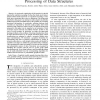Free Online Productivity Tools
i2Speak
i2Symbol
i2OCR
iTex2Img
iWeb2Print
iWeb2Shot
i2Type
iPdf2Split
iPdf2Merge
i2Bopomofo
i2Arabic
i2Style
i2Image
i2PDF
iLatex2Rtf
Sci2ools
TNN
1998
1998
A general framework for adaptive processing of data structures
—A structured organization of information is typically required by symbolic processing. On the other hand, most connectionist models assume that data are organized according to relatively poor structures, like arrays or sequences. The framework described in this paper is an attempt to unify adaptive models like artificial neural nets and belief nets for the problem of processing structured information. In particular, relations between data variables are expressed by directed acyclic graphs, where both numerical and categorical values coexist. The general framework proposed in this paper can be regarded as an extension of both recurrent neural networks and hidden Markov models to the case of acyclic graphs. In particular we study the supervised learning problem as the problem of learning transductions from an input structured space to an output structured space, where transductions are assumed to admit a recursive hidden statespace representation. We introduce a graphical formalism f...
Related Content
| Added | 23 Dec 2010 |
| Updated | 23 Dec 2010 |
| Type | Journal |
| Year | 1998 |
| Where | TNN |
| Authors | Paolo Frasconi, Marco Gori, Alessandro Sperduti |
Comments (0)

